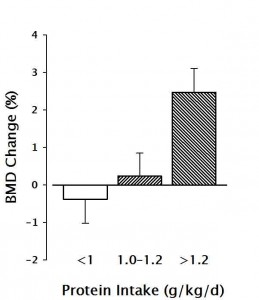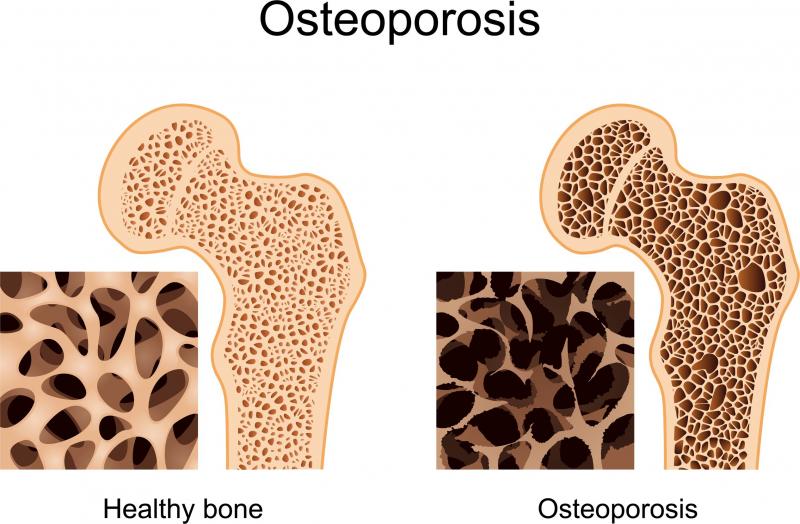Hypothesis: increased bone mineral density needs protein, Ca, Mg, Vitamin D and K
The Paradox of Osteoporosis Irreversibility Dr. Heaney July 2014
He makes a good case for protein being needed to increase Bone Mineral Density (BMD) and has the following chart

Question posted by Vitamin D Life
Is there any evidence that bone structure (spongy latticework ) is rebuilt, rather than just BMD increased with increased protein, Calcium and Vitamin D?
Also - Magnesium and Vitamin K2 are vital for building bones
A Calcium-Collagen Chelate Dietary Supplement Attenuates Bone Loss in Postmenopausal Women with Osteopenia: A Randomized Controlled Trial - 2014
J Med Food. 2014 Oct
Elam ML1, Johnson SA, Hooshmand S, Feresin RG, Payton ME, Gu J, Arjmandi BH.
Menopause leads to an increased risk for osteoporosis in women. Although drug therapies exist, increasing numbers of people prefer alternative therapies such as dietary supplements, for example, calcium, vitamin D, and collagen hydrolysates for the prevention and treatment of osteoporosis.
We have previously shown that a 3-month intervention using a calcium-collagen chelate (CC) dietary supplement was efficacious in improving bone mineral density (BMD) and blood biomarkers of bone turnover in osteopenic postmenopausal women. This study reports the long-term efficacy of CC in reducing bone loss in postmenopausal women with osteopenia.
Thirty-nine women were randomly assigned to one of two groups: 5 g of CC containing 500 mg of elemental calcium and 200 IU vitamin D (1,25-dihydroxyvitamin D3) or control (500 mg of calcium and 200 IU vitamin D) daily for 12 months. Total body, lumbar, and hip BMD were evaluated at baseline, 6 and 12 months using dual-energy X-ray absorptiometry. Blood was collected at baseline, 6 and 12 months to assess levels of blood biomarkers of bone turnover. Intent-to-treat (ITT) analysis was performed using repeated measures analysis of variance pairwise comparisons and multivariate analysis to assess time and group interactions.
The loss of whole body BMD in women taking CC was substantially lower than that of the control group at 12 months in those who completed the study and the ITT analysis, respectively (CC: -1.33% and -0.33% vs. control: -3.75% and -2.17%; P=.026, P=.035). The CC group had significantly reduced levels of sclerostin and tartrate-resistant acid phosphatase isoform 5b (TRAP5b) (P<.05), and higher bone-specific alkaline phosphatase/TRAP5b ratio (P<.05) than control at 6 months. These results support the use of CC in reducing bone loss in osteopenic postmenopausal women.
Google Scholar rsported 84 references of this study as of Jan 2020
Biological effect of hydrolyzed collagen on bone metabolism - 2015, https://doi.org/10.1080/10408398.2015.1038377 FREE PDF
Specific Collagen Peptides Improve Bone Mineral Density and Bone Markers in Postmenopausal Women—A Randomized Controlled Study Jan 2018
ConsumerLab has an extensive review of Collagen supplements - Jan 2020
Amount of Collogen per day varied hugely: from 0.01 gram to 10 grams per day
Cost per gram ranged between $0.05 and $4.
Consumerlab gives a free 5 day trial of their excellent service
See also Vitamin D Life
Healthy bones need Ca, Silicon, Vitamins B, C, D, and K – Dec 2012
Vitamin D levels increased, Bone Density Loss decreased (Tasmania) – March 2021
Pages listed in BOTH the categories Bone and Magnesium
{category}
Pages listed in BOTH the categories Bone and Vitamin K2
{category}
See also web
- Your Bones: How You Can Prevent Osteoporosis and Have Strong Bones for Life-Naturally| March 2013 Amazon Kindle edition <$8
- AlgaeCal + Vitamin D + Strontium + Magnesium + Vitamin K2 + Boron + Vitamin C + Exercise
- ==> 4% increase each year in Dexa-scan T-scores (Bone Density, not bone strength)
- has about 100 pages of endnotes - details
- Bone Carbon 14 dating
- 30% of bone is composed of organic compounds, of which 90 to 95% is collagen
- 70% of bone = inorganic mineral hydroxyapatite, which includes calcium phosphate, calcium carbonate, calcium fluoride, calcium hydroxide and citrate.
- ([Ca3(P)4)2]3.Ca(OH)2)
Vitamin D Life doubts that the resulting increased BMD re-attaches the latticework inside of the bones

